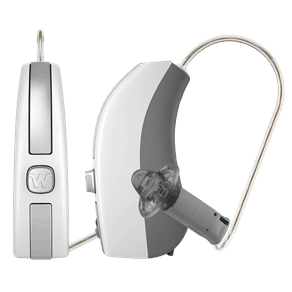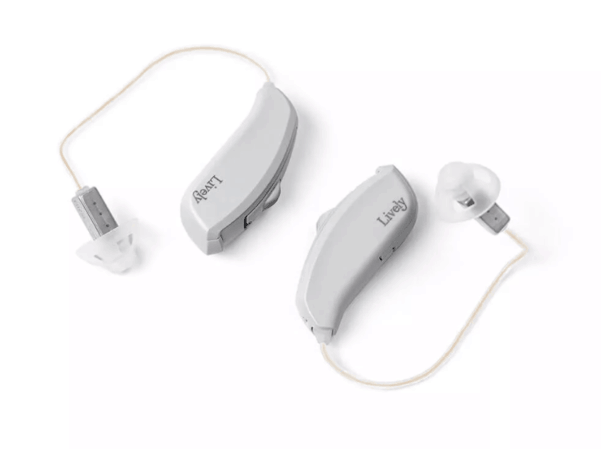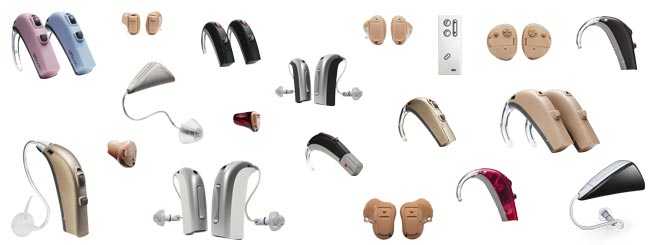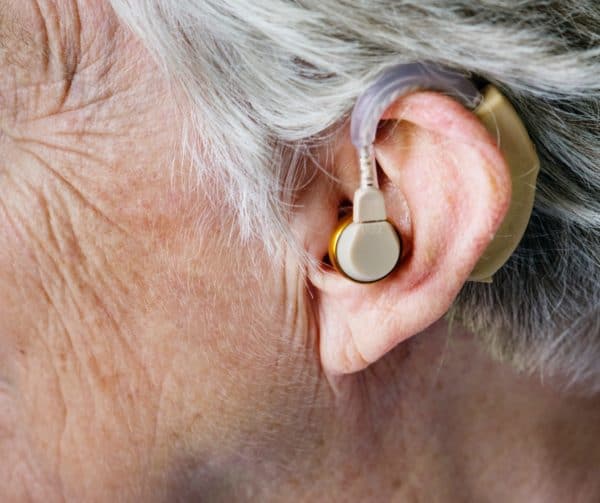Hearing Aid Maintenance: How to Clean Your Hearing Aids

When I first started working as an audiologist in Florida, I quickly learned the importance of keeping hearing aids clean and dry. Living in Florida is like constantly walking around in a sauna; it’s hot and humid. If you don’t keep hearing aids clean and dry, this will affect their sound quality or even make them stop working completely.
Luckily, most modern hearing aids have a nano-coating that makes them water-resistant. So if you regularly dry them out and follow the instructions below, you should be able to keep them sounding great.
FYI:Looking to buy a pair of hearing aids online? Then read our guide to the best OTC hearing aids to find options from $300 per pair.

Hearing Aid Cleaning Tools
Brush
This is a useful tool for all hearing aids styles. Most hearing aids come with a small brush (usually with a wax pick at the end of the handle) but if you have lost the brush a children’s toothbrush is a good substitute. The brush is used to clean dust and debris off the microphones.
Wax Loop/Pick
This small wire loop can be used to scoop wax out of the receiver or mold (the part that plays the sound into your ear canal).
Vent or Tube Cleaner
A vent or tube cleaner looks like a small pipe cleaner or piece of firm plastic floss. This is threaded through the vent to keep it clear of wax. The vent a small hole in an earmold that allows air to get into the ear canal. It can also be threaded through the tube that carrier the sound from the hearing aid to the mold to clear it out.
Soft Cleaning Cloth
A cloth, like those used for glasses or electronic screens, can be used to clean the outside of hearing aids.
Dehumidifying Box
This can be either an electronic box that uses heat, a fan, or a desiccant to dry hearing aids quickly. Another option could be a non-electronic, airtight container with a desiccant.
Tip: If you have rechargeable hearing aids, an electronic drying box might be a good idea, so you have time to quickly dry out your hearing aids before charging them for the night.
How to Store Hearing Aids
When you are not wearing your hearing aids, store them in a clean, dry place, away from pets. Cats and dogs love to chew on anything that reminds them of their owner. You also don’t want to store them in the same bathroom where you take steamy showers! Most hearing aids will come with a case or a charger, so placing your hearing aids in one of these is a great place to start. A dehumidifying box is even better.
The Expert Take:
Kasey Craig
When my patients had rechargeable hearing aids, it was sometimes hard to find time to put them in the dehumidifying box because the hearing aids spend the night in the charging case, not the dehumidifier. However, it is still important that they get dried out regularly. I recommend making it part of your routine to dry out the aids in a dehumidifying box at other times, for example, when you are in the shower.

How to Clean Hearing Aids
In general, the principles of keeping hearing aids clean are the same for all styles: keep them dry and clear of wax, moisture, dead skin, and other obstructions. There are also a few things specific to each style.
If you regularly use aerosols such as hairspray, then it’s best to do your hair before putting on your hearing aids. I have seen some hearing aids that sound dead after a few weeks, all because the microphones are covered in hairspray!
How often you need to clean your hearing aids depends on your environment and how much wax you produce. Many hearing aids have a changeable wax filter on the part that goes inside your ear. How to change the filter can vary a bit from model to model; usually your provider will supply you with some filters and show you how to change them.
Generally speaking, all hearing aids should be inspected and cleaned nightly, although filters are usually only changed every few weeks. Again, this will depend on how much earwax you produce.
Tip: If you find your hearing aids getting clogged up for no reason, take your audiologist through your daily routine. They might be able to identify the cause.
Cleaning In-the-Ear (Custom) Hearing Aids
To clean a custom hearing aid, take a look at the end that goes into your ear canal first, closest to the eardrum. This is where the wax filter will be. If the filter looks clogged, go ahead and change it. You can use alcohol-free cleaner made for hearing aids, in addition to spray or wipes on the aid. If you don’t have these, a dry, soft cloth can remove any wax or debris from the hearing aid.
Additionally, use your brush to clean off the mics. This is the part where the sound enters the aids, and it will be closest to the outside of your ear when the aid is worn. Hold the aids with the mics facing down towards the ground, and brush them off. You might be surprised to see how much dust you see come off them!
Cleaning Tip: Holding your hearing aids with the mics sideways or facing down while you brush will ensure you brush the dust off, rather than pushing it into the mic ports and clogging them more.
Cleaning BTE and Thin Tube Hearing Aids
BTE and thin tube hearing aids don’t usually have a wax filter, but they can get wax trapped in the tube. If you see wax trapped in the tube, remove the dome at the end of the hearing aids. If you have a mold, you should be ok to keep it on. Unscrew the tube from the body of the aid, then run the tube pipe cleaner or cleaning floss through it. It’s important to remove the tube because if you just thread the cleaning line up into the tube while it’s still attached, you could push the wax into the hearing aids.
The outside of molds can be cleaned with a cloth or hearing aid safe wipes or spray. After you clean the mics off (the part where the sound goes in behind the ears) with a brush, screw the tube back on the aid. The tube doesn’t need to be removed and cleaned daily, but it’s a good idea to check it each night when you put it away.
Careful Cleaning: Always clean your aids one at a time so you don’t put the wrong tube and mold back on the aid.
Cleaning RIC Hearing Aids
Here on The Senior List, in our reviews and guides, we usually refer to Receiver-in–Canal (RIC) aids as Behind the Ear (BTE). This is because the hearing aid piece on RIC aids does sit behind the ear. The only difference is that instead of a tube, like “traditional” BTE aids, there is a thin, almost invisible wire that comes down to the ear canal.
To clean RIC hearing aids, begin by taking off the dome and inspecting the filter. If it has wax in it, then it should be changed. If your RICs have molds you might not need or be able to remove them to change the filter. After changing the filter, clean the body of the aid with a cloth, and brush off the microphones with a brush.
The Expert Take:
Kasey Craig
How often you need to change the “wax filter” or “wax trap” can vary greatly from person to person. Some of my patients produce a lot of sticky wax and need to change them weekly, some patients have very little dry wax and can get away with changing it once every six months. I would encourage you to check your hearing aids once a week until you have a good feel for your personal needs. A clogged hearing aid isn’t able to do its job well.
How to Put in Hearing Aids
With hearing aids, red always means right, and blue always means left. Your hearing aids should have red and blue markers on them, most often in the battery door, on the body, or on the molds.
Practice inserting your hearing aids in front of a mirror at first. It might take a few days for it to become second nature. For an in-the-ear aid, they should be comfortable and fit securely because it is molded to your ear. You should feel it slide into the right place.

For hearing aids with a behind-the-ear component, you can start by placing this part at the very top of your ear. The tube or wire should run down the side of your face, right in front of your ear. Once you place the dome or mold end in your ear, the tube or wire should be snug, with no gaps between your face and the aid.
How to Pair Hearing Aids to Your iPhone
How to pair your hearing aid to your smartphone will vary based on the model of your hearing aid and your cell phone. Some hearing aids can be paired in Bluetooth settings; others are paired in an app specific to those hearing aids. It’s best to check the user manual for your model.
If you have an iPhone, you will probably need to open your settings. Go to General > Accessibility > MiFi hearing aids, and then restart your hearing aids to pair them.
For Android phones, the hearing aids are likely paired in their app or in the regular Bluetooth settings.
The More You Know: Be sure to have a hearing aid compatible phone. You can look for this in your phone’s manual. Phones with high ratings of hearing aid compatibility will prevent static and excess noise while placing calls.
Care Tips for Hearing Aids
You probably don’t need to do all the cleaning steps every night, but it’s a good idea to at least wipe down your hearing aids and look over them every night. Change the wax filters when they are full, and get a sense of how often your wax builds up. I have some patients who need to change their filters weekly, while others who can go six months or longer.
The best way to get to know how to keep your hearing aids well maintained is to check them over and give them a wipe down nightly. One of the best things you can invest in, after hearing aids, is a dehumidifier. Moisture isn’t good for hearing aids, and over time, moisture will get through the nano-coating and corrode the hearing aids.
Purchase Wisely: When buying a hearing aid, it’s always best to consult with a hearing healthcare provider, as opposed to purchasing online. This way, an expert can guide you through the process of using and cleaning your aids.
How Long Do Hearing Aids Last?
The average lifespan of hearing aids is three to five years. Hearing aids have tiny mechanical parts, and like anything with mechanical parts, they wear out. They will work better and longer if they are kept clean and dry. If you follow the tips here, in addition to cleaning advice of your hearing healthcare provider, you will get the most life possible out of your hearing aids.

